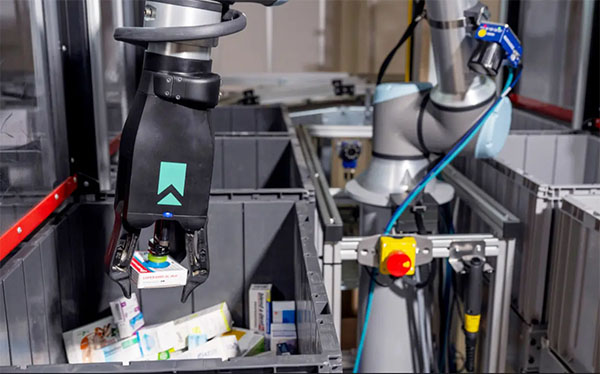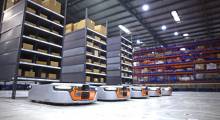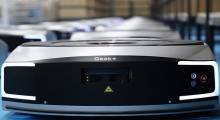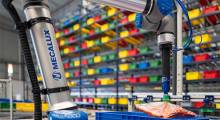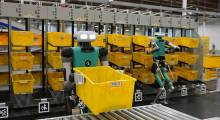Autonomous shuttles and mobile robots can move items in a factory or distribution center, but fast and accurate picking is necessary to fulfill growing volumes of orders. RightHand Robotics Inc. has combined its RightPick 3 picking system, machine learning, and RightCare service to address that need.
The New England Venture Capital Association (NEVCA) this month named Somerville, Mass.-based RightHand the “Robotics Company of the Year” at its 10th annual NEVY Awards. Yaro Tenzer, co-founder and CEO of RightHand, thanked NEVCA and MassRobotics for nurturing innovative startups in the Massachusetts robotics cluster.
Vince Martinelli, head of product and marketing at RightHand Robotics, spoke with Robotics 24/7 about the company's partnerships, the need to consider both humans and automation, and his outlook for 2023.
RightPick and automated storage
What are some of RightHand Robotics' accomplishments from 2022? How do you work with automated storage and retrieval systems (ASRS)?
Martinelli: Last spring, we announced key partnerships with Element Logic, Vanderlande, and a couple of AutoStore partners. We've seen growth and the extension of piece picking with AutoStore's ASRS.
A new customer was Apotea, a Swedish e-commerce pioneer. It started in 1997 with high-value, low unit-volume prescriptions and took the pharmacy online. Today, it has $500 million in revenue and an 80% CAGR [compound annual growth rate] over 10 years.
The European company built a highly automated warehouse, but it didn't want 1 million sq. ft. Sure, Walmart acquired Alert Innovation in October, but ASRS is like an erector set—it can be put up pretty quickly.
With AutoStore and RightPick for inbound receiving and outbound order fulfillment, apo.com's new 220,000-sq.-ft. facility can operate 24/7 and ship €1.5 billion [$1.6 billion U.S.] worth of product a year.
We're building a network to support the growth of businesses. They don't have to be an Amazon or a Walmart.
What are some of the advantages of automation for smaller companies?
Martinelli: In a smaller company, there are fewer layers to sell through. If the CEO decides, it happens.
Larger companies plan buildings over three to 10 years.
RightHand, partners promise to ease robot adoption
How have your partnerships helped widen robotics adoption?
Martinelli: For example, our partnership with Element Logic brings design, installation, and support to 12 countries. Our guys support them with training.
These things take time, but we're starting to see the fruit of these investments. Companies don't have the wherewithal to stitch together conveyors, picking systems, and ASRS themselves, so it's helpful if someone brings the whole thing.
What are some areas where you're seeing demand for RightPick and other technologies?
Martinelli: We recently published a white paper on why picking robots are good for healthcare and pharmaceuticals. People need supplies year-round, and there's less seasonality than in retail.
It can be challenging to find the right payback for automation. RightPick can handle those item sets well, and it fits with Vanderlande totes.
Labor shortages still drive interest in robotics
While growth in e-commerce has slowed since the height of the COVID-19 pandemic, we heard a lot about labor shortages last year. Do you expect that to continue?
Martinelli: We've discussed the growth in e-commerce sales and labor challenges. Businesses need labor to keep scaling up.
COVID changed labor markets, with the “great resignation,” boomers retiring, and immigration restrictions getting tougher. As Joe Campbell at Universal Robots has noted, even if you took all the people who are unemployed, you still couldn't fill the millions of open positions in manufacturing.
Would reshoring of production to the U.S. help or worsen that situation?
Martinelli: It's complicated. Supply chains could shorten, which is nice, but there's still a need for manufacturing talent in the U.S.
Another challenge is that nobody really wants to stand at an ASRS. They'll start to feel more like consumer products for what Gartner called the “gaming generation.”
What are some of the human-centric aspects of working with automation?
Martinelli: It's not just a short-term problem of labor shortages, bussing workers longer and longer distances, or wages not being sustainable. Robots must be designed for the right processes and the people working with them.
The whole industry is coming up the learning curve of how to engage the gamer generation. We're seeing signs of larger companies thinking of using as much automation as is reasonable. It's also helping to bridge the gap in Gartner's “hype cycle.”
Expect more robots, less hype in 2023
What industrial and commercial robotics trends do you expect this year?
Martinelli: One theme is that 2023 will be the most exciting time for robots in warehouses, as well as the beginning of a “boring” era. Picking robots are going to be designed into systems and buildings more often.
Integrators won't have to show one robot before an operator will buy 10; they'll just offer a package of 10 with some manual stations.
Projects won’t get big public announcements. Robotics is still exciting for operators and integrators, but the outside world looks at university research and shiny proofs of concept.
The cadence of success stories will pick up, and the market is hitting an inflection point where end customers will expect picking robots in the mix.
What are some ongoing challenges?
Martinelli: Market penetration is still low. Smaller firms may need only one or two robots, but the cost point and functionality make it hard to succeed.
Companies targeting SMEs [small and midsize enterprises] have a tough model. They have to sell to a lot to smaller shops to make money.
We see robotics as a service [RaaS] helping with machine tending in manufacturing, where the item sets are simpler than in retail.
We've worked with Universal Robots' arms in palletizing and depalletizing, and we also work with robots picking consumer products, like cans and bottles. There's still plenty of room to for robots to meet e-commerce, warehouse, and retail demand.
About the Author
Follow Robotics 24/7 on Linkedin
Article topics
Email Sign Up

